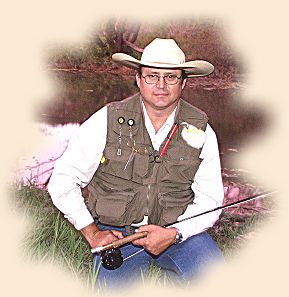Finally vacation time is rolling around. I have been planning
this trip for some time, several days of fishing with my father,
on Lake O.H. Ivie in West Texas. Our purpose is to find the
really large Bream, which include the bluegills and shell
crackers known to inhabit the lake. For whatever reasons
the bull bream get pretty big in this lake, but are hard to
find. Lake Ivie, located between San Angelo and Brady, Texas,
is the largest lake in the area. However due to severe
drought conditions of the last three years, the lake level
has dropped significantly. In much of the backwaters hydrilla
has become predominate and boat passage is difficult. Several
times we had to stop and clean off the boat prop before
proceeding in finding a clear channel. We found that as
long as we stayed in the river channels the water was too
deep for the hydrilla to be of any trouble.
We spent the entirety of the first day just trying to find
where the fish were located. Several locations that were
proven spots of the past years were completely dry and the
now exposed land is covered in salt cedar. The first place
we tried was along some limestone cliffs that were close
to the river channel. In the past these cliffs held some
large bluegills and the water depth was still in the 50
feet range. Moving in among the dead standing trees
alongside the cliff we managed to pick up two large bluegills
in about 30 minutes, but that was it. Since we both picked
up fish at the same time with nothing before or after, it
was a clear indication that they were moving in an unknown
direction along the cliff foraging for food. Due to the
density of the trees it would be useless to try to stay
with the schooling fish.
Next we went to a small inlet where we have caught them
non-stop and all in the 2+ pound range. Again we were
disheartened as we neared the favored spot seeing so much
of the area dry and covered in salt cedar. We pulled up
to some trees where in the past the water depth was anywhere
from 12 - 15 feet and there was only 3 feet and again no
fish activity.
Making our way out to the main body of the lake we actually
became "lost" as there were many points of land and islands
where once was wide open water. The channels in-between
the islands were choked with hydrilla beyond any hope of
passing a boat through. After several detours and false
channels we made our way to the dam. Here the water depth
at capacity is around 117 feet. The deepest we saw that day
was 52 feet. We tried to fish along some cliffs below the
lookout point near the dam. Even though we could not see it,
we were constantly getting fouled in hydrilla trying to get
down to where the bream might be.
As a last resort we went up the Elm Creek branch of the lake
and the first thing we noticed was the disappearance of the
hydrilla and the native broadleaf water plants being more
predominate.
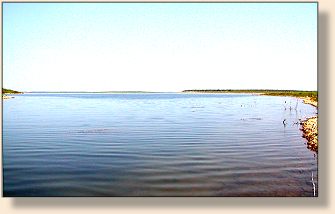
We pulled into one of the inlets where we had first encountered
the large bluegill and shell crackers of five years ago.
 It was much the same as all the other places we saw and again
we had zero hits. We decided this just was not going to work
and maybe hitting the rivers would be more productive. On a
last impulse I banked the boat and walked up the inlet to the
shallow water where the boat could not reach. Upon my approach
there was a lot of activity and hundreds of large bream were
scattering everywhere! The back of the inlet was covered
in beds and very nice sized bream kept each one.
It was much the same as all the other places we saw and again
we had zero hits. We decided this just was not going to work
and maybe hitting the rivers would be more productive. On a
last impulse I banked the boat and walked up the inlet to the
shallow water where the boat could not reach. Upon my approach
there was a lot of activity and hundreds of large bream were
scattering everywhere! The back of the inlet was covered
in beds and very nice sized bream kept each one.
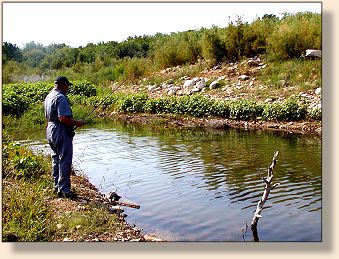
We broke out the fly rods and being that the water was anywhere
from 18 inches to three feet deep we went with the tried and
true top water San Gabriel fly. I used my more resent created
dubbing of purple angora goat hair and yellow angora goat hair,
each mixed with some flash and then alternated on a dubbing
brush. This gave a banded body of yellow and purple with a
lot of flashiness the bream love so much.
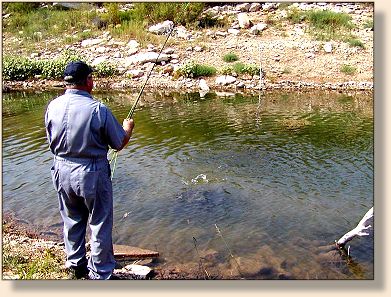
The very first cast didn't even settle well before the first
large bluegill struck.
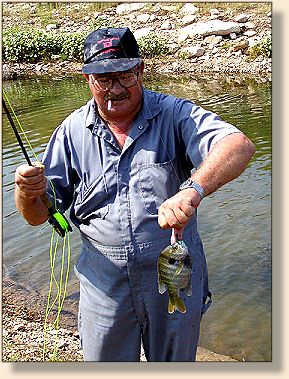
Like I said these bream were large and gave a good fight on
a fly rod! It was great fun before they stopped hitting the
surface. As the days heat built up they stopped surface
feeding and stayed low and close to the beds. Here we
switched over to nymphs and again the action picked up.
Plate size Bream? You be the judge.
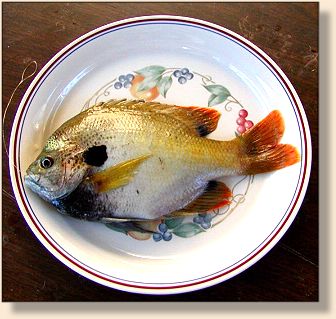
This is a 12inch Dinner Plate.
It ended as a great trip with finally catching some really
nice fish and spending some good quality time with my Dad.
Still waters, fast action? You bet, but I still prefer rivers
and creeks and they will continue to be my dominant haunts.
~ Hillfisher
|

